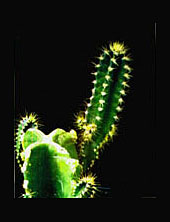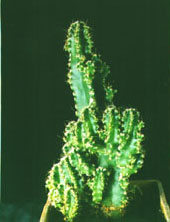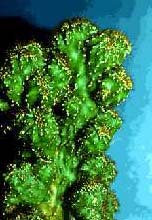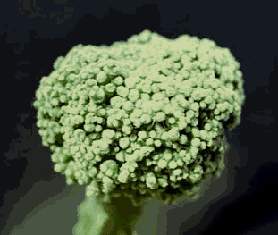MONSTROUSNESS
Igor Skulkin, Ph.D.
The reason for appearing monstrous or rocky or shapeless forms of cacti is to our mind full or partial relief of apical domineering with the following disorderly overgrowth of suckers. The most known monstrous forms belong to Cereuses (photo 1-3), in particular to Cereus peruvianus. These forms practically never bloom though normal plants bloom rather late.

| 
| 
|
Photo 1.
Photo 1a.
| Photo 2.
| | |
As growing older the suckers of such monstrous plants tend to defasciate. We believe there is another variant of monstrousness that can be called micromonstrousness (Neogomesia agavioides, Copiapoa tenuissima, Neoporteria gerocephala and other (photo 4-5). These plants develop chaotically small branching shoots. The texture or their areolae is partially juvenile and has no thorns.

| 
|
Photo 3.
| Photo 4.
| |
 |
| Photo 5. |
An unusual feature of these plants is continuous developing of bud rudiments almost in every areola which almost never grow to the normal size and open. This is a surprising fact as in usual conditions normal plants of these species not always bloom, and if they do it happens in mature age. The reason of why monstrous forms are not widely spread is not only in that they appear rather rarely but also that they restore quickly apical domineering and turn to multihead forms which belong to the first type of fasciation. Besides I should say that there are no cases of monstrous forms found in the wild nature described in the literature.
The 6-month seedling of Notocactus floricomus that we watched developed for about 2 months as a monstrous from but then gave about 30 normal shoots, the central developed quicker than the lateral. So, relief of apical domineering can lead to monstrousness and polytomy, but the latter may have other causes as well.





